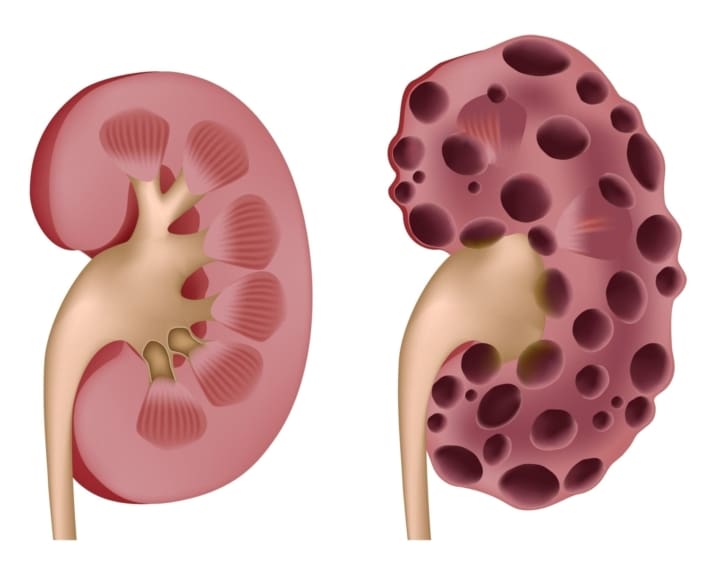
What is polycystic kidney disease?
Polycystic kidney disease (PKD) is an inherited disease that affects the kidneys. Inherited means it runs in families and is passed down from parents. It causes abnormal sacs of fluid (called cysts) to grow in the kidneys. If too many cysts grow or if they get too big, the kidneys become damaged. The cysts may also cause pain or get infected.
PKD is the most common inherited disease in the United States. Children of parents who have PKD have a 50% chance of getting the disease.
Symptoms of polycystic kidney disease
The most common symptom is high blood pressure. About 60% of people who have PKD also have high blood pressure, which can be treated with medicine. Other symptoms include:
- Pain in the back and side
- Blood in the urine
- Frequent kidney infections
Not all patients will have all of these symptoms. For many people, PKD is mild and causes only minor problems. For others, PKD is more severe and can cause kidney failure. About 50% of patients who have PKD have kidney failure by age 60. Dialysis (blood filtering) and kidney transplants are both effective treatments for kidney failure.
People who have PKD may also have cysts in the liver, but these cysts seldom cause problems. Other organs that may be affected include the heart, brain, intestines, pancreas, ovaries, and spleen. PKD can cause problems with heart valves in some people. When PKD affects the brain, it can cause an aneurysm (a bulging blood vessel that can rupture).
What causes polycystic kidney disease?
Genes tell your body how to work. When you have PKD, there’s something faulty with your genes, and they don’t tell your body how to work correctly. That leads to the problems with PKD. Genes are passed from a parent to a child. The bad genes that cause PKD can be passed from a parent to a child. That’s how PKD runs in families.
PKD is generally worse in men, African Americans, and people who have sickle cell disease. There is also a childhood form of PKD, which is usually more severe than the type that occurs in adults.
How is polycystic kidney disease diagnosed?
PKD is often diagnosed when a person begins to have symptoms or is at risk for the disease.
Your doctor may want you to have an ultrasound imaging test or a CT (computerized tomography) scan. An ultrasound uses sound waves to create a picture of your organs. A CT scan uses many X-rays to form pictures of your organs. Both tests are painless and can detect cysts on the kidneys.
PKD also can be diagnosed in unborn babies using a test called amniocentesis. During this test, doctors take a very small amount of the amniotic fluid from the womb. They test the fluid for PKD. Another test, called chorionic villus sampling, involves testing a very small piece of the placenta. If you have PKD and you’re pregnant or planning on becoming pregnant, talk with your doctor about these procedures.
Can polycystic kidney disease be prevented or avoided?
There is no way to prevent polycystic kidney disease. There is also no cure. However, you can manage symptoms of PKD through lifestyle changes and medication. Talk to your doctor about how to best manage your symptoms.
Polycystic kidney disease treatment
No treatment is available for the cysts caused by PKD. If the cysts are causing symptoms, the symptoms can be treated to make you more comfortable.
Living with polycystic kidney disease
If you have PKD, it’s important to get regular checkups and talk with your doctor. Managing PKD is easier when you eat a well-balanced diet, so talk with your doctor about what foods you should and shouldn’t eat. You should also stay physically active.
It’s especially important to monitor and control your blood pressure when you have PKD. This can help slow the growth of cysts. It also helps prolong kidney function.
If you have PKD and you also have a relative who has had a brain aneurysm, your doctor may suggest that you have a CT or MRI (magnetic resonance imaging) of your brain to check for an aneurysm. (MRI uses a magnetic field and radio waves to produce a picture of your brain.) If you’re at high risk of an aneurysm, your doctor may suggest you have CT or MRI of the brain every few years to detect an aneurysm before it causes problems.
Questions for your doctor
- What treatment is best for my symptoms?
- How can I know if my baby has PKD?
- I have PKD. Is it certain that my children will have it?
- If my symptoms get worse, when should I call my doctor?
- What kinds of tests do I need to diagnose PKD?
- Will my PKD affect any of my other organs?
- Are there any medications I should take?
- What is the best way to treat my high blood pressure?
- What side effects will I experience from my medications?
- What kinds of complications can I expect?
Resources
![]()
Copyright © American Academy of Family Physicians
This information provides a general overview and may not apply to everyone. Talk to your family doctor to find out if this information applies to you and to get more information on this subject.






